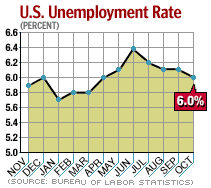NEW YORK (CNN/Money) -
This month, the federal government is due to end its temporary program of offering extra unemployment benefits to people whose state benefits expire, a program that's helped about 300,000 people a month.

With the economy recovering and the labor market showing signs of life, some observers and politicians say the time is right to cut off the federal benefits, while others worry the labor market isn't yet healthy enough to run on its own.
Early last year, Congress made Temporary Emergency Unemployment Compensation (TEUC) part of a broader economic stimulus package, offering up to 13 extra weeks of jobless benefits for people who had exhausted their regular, state-paid benefits. Since then, the federal government has paid about $900 million a month in TEUC benefits.
After two extensions, the latest last May, the program is scheduled to end Dec. 27, and there appears to be little appetite among elected officials from either political party for another extension. Congress recently ended its latest session without having raised the issue, though there's a chance it could be raised again when lawmakers convene during the recess to finish up some spending bills.
The time would seem to be right to let the program die.
The economy grew at an 8.2 percent clip in the third quarter and is likely to show reasonably strong growth again in the fourth quarter. Meanwhile, new weekly claims for state jobless benefits have tumbled to the lowest level in nearly three years, and some consumer surveys indicate that jobs are becoming easier to find.
House majority leader Tom DeLay recently told the Bureau of National Affairs that the economy is in better shape today than it was in 1993, when the Democratic Congress ended its own temporary benefits program, and that it's time to do the same thing again.
It's an argument that appeals to some economists, especially with the federal budget sinking into ever-deeper deficits.
"It looks like the economy is back on track; every indicator is looking up, and we've even had a couple months of employment growth," said Steven Cochran, director of regional economics at Economy.com. "The federal government has pumped billions of dollars into the economy in the past two years, and one could argue that enough is enough, it's time to let the economy go on its own."
Out of the woods yet?
But with more than 2 million Americans having been unemployed for 27 weeks or more, according to the latest Labor Department statistics, some liberals argue that the labor market is still too weak to be left on its own.
The left-leaning Center for Budget and Policy Priorities (CBPP), a Washington think tank, last week issued a statement noting that several labor market indicators are worse than they were in March 2002, when the TEUC program was initiated:
- The unemployment rate is higher -- 6 percent vs. 5.7 percent
- The number of unemployed is greater -- 8.8 million vs. 8.2 million
- The number of long-term unemployed is greater -- 2 million vs. 1.3 million
- The number of jobs available is smaller -- 130.1 million vs. 130.5 million
- And the number of payroll jobs outside the farm sector is still 2.4 million lower than in February 2001, before the latest recession
| Related stories
|

|
|
|
|
"The economy is picking up, and it appears the job market has picked up as well, but it is going to take a while to get back on track in terms of a healthy job market, so we still need this program," CBPP senior fellow Isaac Shapiro told CNN/Money.
Shapiro estimates that 80,000 to 90,000 people will lose their state benefits each week after Dec. 27. While some states are offering their own extended-benefit programs, others are not, leaving thousands of people high and dry and raising the risk that consumer spending, which fuels more than two-thirds of the total economy, will slow in 2004.
But from a cold-hearted, academic point of view, the total economic impact of ending the benefit seems unlikely to be great, some analysts said, in part because many of those out of work will at least be able to find lower-paying jobs, meaning they will be able to survive -- though precariously.
 |
YOUR E-MAIL ALERTS
|
Follow the news that matters to you. Create your own alert to be notified on topics you're interested in.
Or, visit Popular Alerts for suggestions.
|
|
|
And the fact that many of the job cuts in the recent downturn were permanent layoffs -- as opposed to the good old-fashioned temporary layoffs of the 1970s and 1980s -- could mean the government might better spend its money in other ways, such as worker retraining or relocation.
"It comes down to a political choice," Citigroup senior economist Steven Wieting said, "whether this is the kind of thing where you happily wait and continue unemployment insurance in the hope that certain industries bounce back cyclically, or you accept the fact that certain job categories are gone for good."

|

